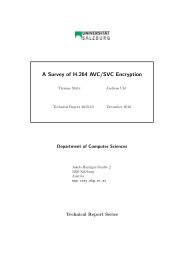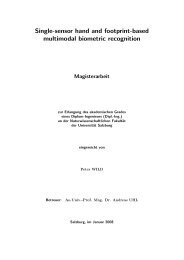Pit Pattern Classification in Colonoscopy using Wavelets - WaveLab
Pit Pattern Classification in Colonoscopy using Wavelets - WaveLab
Pit Pattern Classification in Colonoscopy using Wavelets - WaveLab
Create successful ePaper yourself
Turn your PDF publications into a flip-book with our unique Google optimized e-Paper software.
5.2 Results<br />
As we can see from table 5.3, <strong>in</strong> the two classes case the best result obta<strong>in</strong>ed for the pit<br />
pattern images was 74%. It is worthwhile to mention that the classification of the nonneoplastic<br />
images results <strong>in</strong> a very high classification rate of 95% while the classification of<br />
the neoplastic images reaches a classification rate of 59% only.<br />
In the six classes case the classification result is 43% with a very high classification rate<br />
of 95% for pit pattern type I and very high misclassification rates for pit pattern types II,<br />
III-S and V.<br />
<strong>Pit</strong> <strong>Pattern</strong> Type Non-Neoplastic Neoplastic<br />
Non-Neoplastic 95 5<br />
Neoplastic 41 59<br />
Table 5.16: Result distribution matrix for CC for 2 classes (<strong>Pit</strong> pattern images)<br />
<strong>Pit</strong> <strong>Pattern</strong> Type I II III-L III-S IV V<br />
I 95 0 5 0 0 0<br />
II 91 0 9 0 0 0<br />
III-L 20 0 7 0 73 0<br />
III-S 25 0 25 0 50 0<br />
IV 46 0 2 0 52 0<br />
V 72 0 20 0 0 8<br />
Table 5.17: Result distribution matrix for CC for 6 classes (<strong>Pit</strong> pattern images)<br />
The tables 5.16 and 5.17 show the result distribution matrices for the two classes case<br />
and the six classes case, respectively, us<strong>in</strong>g pit pattern images. For the two classes case,<br />
as already stated above, we observe significantly better classification results for the nonneoplastic<br />
images. For the six classes case we observe a poor classification performance for<br />
pit pattern types II, III-S and V. If wee look at table 5.17, we see that most of the type II<br />
images are misclassified as be<strong>in</strong>g of type I, which expla<strong>in</strong>s, why the classification for type<br />
II is that poor. This behaviour can also be observed for images of type V.<br />
Figure 5.13 shows the distance matrices for the two classes and the six classes case. The<br />
red bars at the top and the left of the images denote the different classes. Compared to the<br />
example distance matrices presented <strong>in</strong> figure 4.5 (section 4.3.4) we can clearly see, that<br />
there is no visible structure <strong>in</strong> these matrices.<br />
Test<strong>in</strong>g this method with the outex images resulted <strong>in</strong> fairly good results as can be seen <strong>in</strong><br />
tables 5.4 and 5.5. For the two classes case the best overall result was 98%, while <strong>in</strong> the six<br />
classes case the best classification result is only 74% which is a fairly bad result compared<br />
to all previous methods.<br />
While <strong>in</strong> the two classes case the result distribution matrix is nearly identical to the result<br />
distribution matrices for the previous methods <strong>in</strong> conjunction with the outex images, the<br />
87








